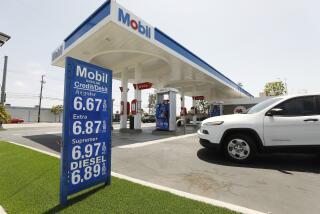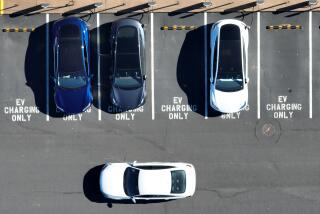Governor Pushes for ‘Hydrogen Highways’
Gov. Arnold Schwarzenegger wants to speed California drivers to a future in which the most common element in the universe -- hydrogen -- will power their cars instead of petroleum.
To wean a gas-guzzling nation from a finite supply of fossil fuels, the governor has thrown his weight behind “Hydrogen Highways,” an ambitious but costly plan to build a statewide network of 200 hydrogen filling stations by the end of the decade.
The investment is necessary, proponents say, because without refueling stations, automakers may not produce enough of the alternative cars and consumers will not buy them.
Stations would be located every 20 miles along major highways and interstates. Each station would cost $250,000 to $500,000, and the total expense could run into the hundreds of millions of dollars. The undertaking would be financed with a combination of public and private money.
The governor’s proposal is part of a broader effort in California and across the nation to promote hydrogen fuels, which offer the promise of cars that emit few or no air pollutants.
Many environmentalists and government officials are embracing hydrogen as the technology of tomorrow, envisioning an era when gas prices will not fluctuate according to Middle East politics and tailpipes no longer will emit exhaust that adds to global warming and smog.
But skeptics say that although hydrogen vehicles may indeed be the cars of the future, that future is still decades away. They warn that California could be embarking on another environmental boondoggle, much like the electric-charging stations that the state helped finance and that go largely unused. Many questions about how the cars and the hydrogen fuel would be mass-produced remain unanswered.
Joseph Romm, who oversaw energy efficiency programs in the U.S. Department of Energy during the Clinton administration, said he counts himself a proponent of new technologies.
But Romm, who has written a book titled “The Hype About Hydrogen,” which is to be published this spring, said the fuel will not be used to run passenger cars in significant numbers before 2030. He said the most viable step away from gasoline-powered cars -- hybrid vehicles, such as the Toyota Prius -- is already here.
“The vehicles are going to be too expensive. The fuel is going to be too expensive. There are going to be safety issues. Who is going to buy these cars?” Romm said.
“People are not going to go through all the trouble of buying a hydrogen car, which is going to have all these limitations, when it won’t even be as environmentally beneficial as a Toyota Prius when you consider the environmental cost of making that hydrogen fuel.”
Hydrogen can be used to power cars in two ways: as a replacement for gasoline in an internal combustion engine, or as a source of power for a fuel cell. A fuel cell combines hydrogen and oxygen to produce electricity, which powers the vehicle and emits only steam.
Today’s hydrogen fuel cells cost 10 times as much to produce the same energy as the drive train of a car powered by a gasoline-powered internal-combustion engine, according to the Energy Department.
Because so few fuel cell cars have been built -- about 60 are in service in California -- they are costly, about $1 million apiece to produce today. Their range is limited to about 200 miles before refueling, much less than the range of a gasoline car. Increasing the range would require more fuel tanks, which would take up too much space in the vehicle, according to the Energy Department.
The cars being road-tested in California were provided by the auto industry to universities, cities and public agencies
Hydrogen fuel made from natural gas costs about $4 per gallon. It costs more than three times that much if made from water, though the Energy Department’s goal is to reduce the cost to $1.50 per gallon, excluding taxes, by the end of the decade.
Hydrogen Highways is a key element of the governor’s environmental platform. He promoted it during his election campaign and in his State of the State address.
Schwarzenegger has promised to convert his own Hummer to run on hydrogen. He has not done that yet, but the move would be an answer to critics who chide him for his love of the lumbering vehicles, which are known for their low gas mileage.
California can afford to pursue Hydrogen Highways during its budget crisis because companies have agreed to help build some of the fueling stations and to shoulder most of the early costs, said Terry Tamminen, the governor’s environmental secretary. No money was included in this year’s budget for the proposal.
“This is not, in my view, anything close to pie in the sky,” Tamminen said. “What we are talking about is aggregating a number of projects that are already underway. The car companies fought the whole electric vehicle mandate tooth and nail, and invested close to nothing. Hydrogen is different. They are investing in this technology, and believe it can work.”
Nearly every major auto manufacturer in the world has a hydrogen-car program and demonstration fleets are scheduled for launching through 2006. The auto industry says it is pouring billions of dollars into research on the new technology. In Tokyo, fuel cell minivans are being used already. Toyota, Nissan and Honda have pledged to put 50,000 of the cars on the road by 2010.
Highway rest stops and state-run maintenance yards could be converted to new filling stations. The South Coast Air Quality Management District is building 14 hydrogen stations in Southern California, which will serve visitors to Los Angeles International Airport and clean-car fleets in Burbank, Ontario, Riverside, Santa Ana and Santa Monica. Once California has 100 stations operating, it could float revenue bonds to be paid off by proceeds from hydrogen fuel sales to finance the remaining effort, Tamminen said.
Automakers say hydrogen could revolutionize automotive designs and result in cars that run more quietly and cleanly. The cars could produce enough power to run electronic devices on board with energy to spare for construction machines or camping equipment. Such a car could even be plugged into a house to reduce electricity bills.
“Someday, personal transportation is going to switch to hydrogen and fuel cells. There’s nothing else that can fit the bill. The question is when and how,” said David Garman, assistant secretary of the Energy Department.
The Bush administration is spending $1.7 billion over the next four years on its Freedom Car program and the Hydrogen Fuel Initiative. President Bush also has proposed spending $55 million to build a national network of hydrogen refueling stations. Schwarzenegger has met with Energy Secretary Spencer Abraham, and California hopes to receive some of that money, officials said.
The state Air Resources Board tweaked its zero-emission vehicle regulation last year to promote hydrogen-powered cars. The regulation requires automakers to offer 50,000 such cars for sale in California, the nation’s largest auto market, by 2017. Los Angeles, Torrance and San Francisco already are using a few cars powered by fuel cells. Michigan, Ohio and Connecticut are pursuing programs to manufacture fuel cells and deliver hydrogen fuel.
The Hydrogen Highways proposal bears resemblance to paths previously traveled in California, where the pursuit of a smog-free car has become a holy grail. Some of those roads have led to dead ends.
California authorities promoted methanol as a replacement for gasoline in the 1980s, but it did not work out. In the ‘90s, battery-powered electric cars stalled because of technological limitations.
Some experts are concerned about a headlong rush to hydrogen. They say that numerous technological and economic challenges must be overcome and that it will be decades before the fuel makes any significant penetration in the economy. They warn that the switch to hydrogen must be flexible and well-planned to avoid the same fate as the earlier efforts.
Johannes Schwank, director of the Hydrogen Council at the University of Michigan, said government and industry efforts to promote the “hydrogen economy” are advancing but are not well-coordinated.
Among the key questions yet to be resolved: Should cars burn hydrogen or derive electricity from nonpolluting fuel cells? Should hydrogen fuel come from green sources, such as water or biomass, or from fossil fuels? Will the fuel be made at processing plants or by household devices, or will it be produced on board the vehicle?
“It is wonderful to see initiatives going forward because it is important to address this question of how we go to a hydrogen future, but there are so many forks in the road,” Schwank said. “We are too early in the game to start making major expenditure decisions. We need to think this through more carefully.”
Proponents envision a two-step transition, with cars first burning hydrogen to generate power through internal combustion and later models switching to the more advanced fuel cells.
There are concerns, too, that fuel cells do not perform well yet in cold climates; water is a byproduct of electrical production and the fuel stacks freeze in frigid climes.
Technological improvements are being made, but the Energy Department estimates that affordable, reliable fuel cell cars will not appear in auto dealer showrooms until 2020.
“Is it going to be easy? No. Is it a given? No. There are many hurdles to cross,” said Alan Lloyd, chairman of the state Air Resources Board.
But environmentalists, air quality officials and automakers remain bullish on the technology.
General Motors says it wants to be the first auto company to sell 1 million hydrogen-powered cars. GM’s goal is to have the first commercially available fuel-cell car available in dealer showrooms in several years, though the company is not sure what sort of vehicle it will be.
“We expect to have a commercially viable fuel cell by 2010, a vehicle that can be bought by consumers. It won’t cost more than the other vehicles in that category on that day,” said GM spokesman Scott Fosgard.
Scott Samuelsen, director of the National Fuel Cell Research Center at UC Irvine, is testing two Toyota Highlanders powered by fuel cells.
“It drives as good as a gasoline vehicle, and has the additional ambience of being quiet and no vibration,” he said. “I have my own gasoline Highlander and I have trouble going back to that car after driving the fuel cell vehicle.”
More to Read
Get the L.A. Times Politics newsletter
Deeply reported insights into legislation, politics and policy from Sacramento, Washington and beyond. In your inbox three times per week.
You may occasionally receive promotional content from the Los Angeles Times.










